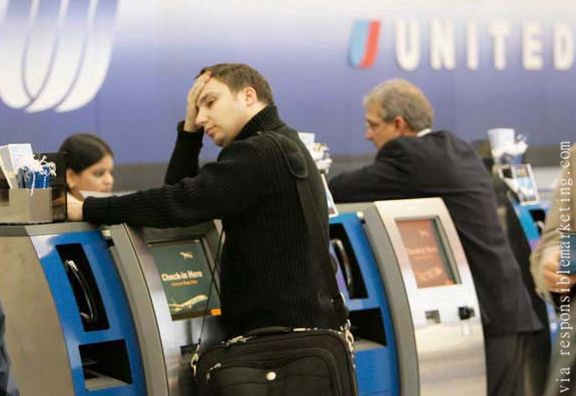We expect organizations to get better at what they do. But many atrophy, sometimes because of the rules-based digital systems on which they depend.
Despite clear advances in information systems, there is obvious evidence that many organizations are faltering in their abilities to provide services to their clients and customers. We expect organizations to get better at what they do. But it seems that the older the organization, the more it is likely to atrophy, sometimes because they opt for incremental fixes for core problems. A big claim, to be sure. But the increasing longevity of Americans makes it possible for more of us to see the decline of services over time.

Consider a recent personal case. An direct flight from the northeast to Chicago should take just under two hours. That is what I thought when I boarded a plane in Philadelphia bound for Chicago’s O’Hare. But the United flight was delayed in leaving due to a glitch in an old Boeing 737 that was probably older than my students. We left about 40 minutes late, not that unusual. Partly because of the delay, we were effected by afternoon thunderstorms building up over O’Hare, leaving us with too little fuel to wait them out. So we eventually diverted north to Grand Rapids Michigan to get more fuel, and to continue to work on the maintenance issue.
As luck would have it, several families on the plane were actually going to Grand Rapids via a previously arranged connection in Chicago. So the fates delivered them to their city. Or so they thought. But despite the two-hour wait on the tarmac just short of a gate, the folks who could practically see their neighborhoods from their seats were not permitted to leave. Apparently security rules don’t allow people to change their routing. So they sat all afternoon, waiting with the rest of us to move on to an overcrowded O’Hare on the other side of Lake Michigan. Of course they then needed to find a new connection to get back to where we had just come from. This is surely not what previous generations meant about “American know-how.”
The problem here was the weather, a badly outdated plane, corporate indifference, and digital security systems constructed as a series of binaries. These days you are captive to your airline until you reach your final destination. But not that many years ago baggage could be pulled from the hold if a passenger’s plans changed.
As it happened, our return later in the week was not much better, leaving Chicago after 6:00 p.m. and not reaching our home until the next day at 2 a.m. because of more ground delays.
Crowded skies and over-scheduled airlines now make flying an endurance test for travelers that are amazingly passive and compliant. One friend described a direct flight from Albuquerque New Mexico to New Jersey that went from a scheduled four hours to nearly three full days and two unscheduled hotel stays.
Don’t fault the young; it’s all they know. But my independent-minded ancestors would have never stood for it, surely ending up on no-fly lists if they were still with us.
To be sure, travel horror stories aren’t new. But they are representative. The point is that, like the airlines, more organizations seem to be expanding their “services” by setting up systems that can’t deliver on what was originally promised. That’s sometimes true in bank and financial services, consumer loans, appliance repair, medical insurance and governmental services: everything from basic road repairs to enrolling for Social Security. Even appliances in need of simple fixes are now tossed rather than submitted to the vagaries of a service gauntlet.
![]()
These days most corporate dollars seem to go into marketing rather than customer service.
We sense the problem when a call to a service provider for help. The usual routine is that a robotic phone or online system takes over. It typically allows for only a certain number of categories of response. Questions that are preset by the service provider are a cheap if deficient solution for “listening” to what another wants to say. Short of buying a yacht, no one in most organizations really wants to talk to you. These days most corporate dollars seem to go into marketing rather than customer service.
There are notable exceptions. One reason the behemoth Amazon is so popular it that it usually delivers on its what it promises. UPS has also been a part of that success. Others report good results with some car makers, insurance providers like AARP, and a large number of streaming services. These are in sharp contrast to essential human services that have been squeezed by tight state budgets and plain old bureaucratic ineptitude. For example, it’s a small kindness to not ask commuters in New York of Washington D. C. to ask about their subway commutes. These publicly financed systems are struggling. But service problems are often just as bad in large businesses with bloated management costs and under-paid line personnel. If you have challenges using the Post Office or a government body, look to the top, not the bottom. Problems with mail or Amtrak or the Affordable Care Act should be laid at the doorstep of our politicians, not their workers.
A sorry solution for organizational atrophy is to find refuge in the software of amusement. It’s tempting to ‘visit’ places online rather than bother with the physical trip. The tether of a screen seems to function as our escape route. Even so, and as challenging as it is, flying is still an amazing experience. The thrill of seeing our world from the other side of the clouds should always matter. And yet I traveled in a blackout on my trip to Chicago. Passengers near me on both sides of the plane kept their window shades down so they could play games on their phones.
![]()

